The other day, my friend told me about their morning smoothie recipe that included oat milk, a whole banana, a cup of mixed berries, and a few dates… I did the math, and with those ingredients alone, it contained upwards of 40 grams of total sugar!
Dang! That’s more than a large bowl of Lucky Charms cereal!
Smoothies hold the potential to pack in a ton of nutrition, but if it comes at the cost of sending our blood sugar through the roof, the cons might outweigh the pros.
That’s why I’m so pumped to share with you my three favorite smoothie recipes that won’t spike your blood sugar.
Don’t believe me? For proof, I had my co-writer test each recipe on her Levels continuous glucose monitor (CGMs) to assure you they are not only delicious but blood sugar spike-free.
My smoothie recipes are low-glycemic, nutrient-dense, and high in quality protein and fat. Oh, and they taste freaking amazing, which is hard to come by in a low-glycemic smoothie.
If you’re not a fan of the ingredients I chose to make my smoothies, I have a step-by-step guide on how to pick the right ingredients to build your own delicious smoothie that will keep your blood sugar stable all morning long.
But first, let’s talk about why the heck smoothies are such a culprit for spiking our blood sugar.
Sugar Is Sugar Is Sugar…
Before we get into a few nuances, I first want to say that I’m not here to demonize fruit. When we consume fruit as nature intended (with the fiber intact), we get access to a plethora of antioxidants and polyphenols that our body and our gut craves.
But the challenge is, when we blend fruit for smoothies, its fiber is ground up as if it has already been chewed. And fiber is kind of like the “holy grail” for keeping our blood sugar in check after eating a piece of fruit.
Without the fiber intact, we’re left with a cup full of sugar that spikes our blood glucose first thing in the morning. As a result, we’re left pretty much eating dessert for breakfast.
When your blood sugar spikes after eating or drinking something sweet, insulin is released to bring it down. This is a normal process that your body is designed to do so your blood sugar stays in balance.
But if this keeps happening, again and again, it leads to metabolic dysfunction, insulin resistance, and all the negative health effects that go along with it.
Plus, if insulin is high most of the time, your body goes into energy storage mode and converts that sugar into fat (belly fat, in particular). Whether it comes from blended fruit or a Snickers bar—sugar does not discriminate.
My Smoothie Hack For Better Blood Sugar Control
I don’t want to diss on smoothies too hard because I’m still a huge fan of them. On busy mornings or days where I have meetings straight through lunch, I’ll whip up a smoothie to get the fat, protein, and fiber I need to keep my brain sharp, focused, and energized.
But I’m super conscious of the ingredients I use to make sure they don’t spike my blood sugar. Instead of using high-glycemic fruits like pineapple, mangoes, and bananas, I use low-glycemic fruits like berries.
I pair these with healthy fats (like avocado, nut butter, and cacao powder), fiber (raw nuts and seeds), leafy greens, and high-quality protein powder, so my blood sugar stays smooth and steady all morning long.
Smoothie With Confidence
In my protocol this week, I’m going to give you my three favorite smoothie recipes that taste amazing and contain ZERO added sugar, sweeteners, juice, or high-glycemic fruits. I carefully selected the ingredient combinations to offset the sugar that’s naturally present in the fruit (with fat and fiber) and used vanilla extract for a hint of sweetness.
I also included pictures of the finished product (in traditional smoothie fashion and smoothie bowl form) and screenshots of Taylor’s and my zone scores for each recipe straight from the Levels app. A zone score of “10” indicates an optimal blood glucose response (I’ll give you a hint: they all received a perfect “10”).
Please note: everybody is different, so just because a recipe didn’t spike me doesn’t mean it couldn’t spike you (that’s why I love CGMs, because they allow you to get super personal with your diet). However, I can say with confidence that these homemade smoothie recipes won’t be spiking your blood sugar as much as traditional ones.
The Protocol:
Before we get into the recipes, I want to cover the basics for picking out the core ingredients for your smoothie. That way, if you’re not a fan of some of the ingredients I used or have dietary restrictions that keep you from using them, you can feel free to swap them out for other quality ingredients to make them your own.
A great-tasting smoothie that’s good for you (and your blood sugar) combines a few basics: some type of milk or water, protein, fiber, fat, and low-glycemic fruit (sometimes). Here are a few of my go-to’s in each category just for reference:
I. Know Your Base. Choose any of the below options to make sure your smoothie blends nicely and has the right consistency.
Try This:
1. Clean Plant Milk: Most plant milk contain gums and emulsifiers that negatively impact your microbiome, in addition to artificial preservatives and loads of added sugar. I’m not crazy worried about them, but if you have shakes/smoothies often it’s good to move away from these potentially harmful ingredients.
Here are my guidelines for picking out a clean plant milk: 1) Go for unsweetened with 1 g or less of total sugar per cup; 2) no artificial flavors; 3) no gums or emulsifiers. And if you can’t find one without artificial flavors and emulsifiers it isn’t the end of the world : )
Weeding through all the plant milks out there to find one that meets the mark takes time and can feel damn near impossible. Below are a few brands I’ve come across that fit the above criteria.
- Malk Organics. I like their unsweetened vanilla almond milk with natural vanilla flavor derived from vanilla beans.
- Elmhurst. This brand carries a variety of clean nut milks. In addition to almond milk, they sell walnut, macadamia, and cashew milk. I can’t do cashews, their high lectin content doesn’t agree with me, but that’s another option if you can tolerate them.
- Native Forest Unsweetened Organic Coconut Milk. I used to love all things coconut but recently had to cut back because I overdid it and it started messing up my gut. But I know some people really like it, so this is a clean-ingredient option.
What About Oat Milk? Steer away from oat milk since it’s very high glycemic and a potent blood sugar spiker, even if it’s unsweetened.
Clean store-bought plant milk can get expensive, so please keep that in mind. But eating healthy doesn’t have to break the bank. There are some other options out there you can experiment with that are just as good!
2. Homemade Almond Milk or Nut Milk. Believe it or not, it’s really easy to make plant milk from scratch.
- Here’s an Almond Milk Recipe from my friend Chris Kresser’s blog that’s super simple.
- You can also try this Speedy Homemade Nut Milk recipe I learned from a friend a few years ago. All you have to do is take two tablespoons of your favorite nut butter, blend it in a 16-ounce cup of water, add a tiny pinch of salt and a drop of vanilla extract for flavor. BOOM! You have nut milk!
3. High-Quality Dairy. Most dairy products on the market today are low quality. However, if you can tolerate dairy (I can’t) and are getting it from a super high-quality source, it can be a good source of nutrition. A full-fat option will help offset any blood glucose spike from lactose (milk sugar).
Organic, grass-fed (if possible) dairy products are the best option to avoid antibiotics, growth hormones, and other inflammatory drivers in conventional dairy products. I don’t do well with dairy at all, and I find that’s the case for most people. If that’s you, skip out on it entirely when it comes to smoothies and opt for high-quality clean plant milk like the ones listed above.
My co-writer Taylor told me that she uses raw goat’s milk in her smoothies and loves the taste it brings. She has some autoimmune stuff, and says raw goat’s milk doesn’t cause her to have any flare-ups or spike her blood sugar. So if you’re interested, that’s another option.
4. Water. Using good ol’ water in your smoothies is always an option, too. If you have the right mixture of ingredients, your smoothie will still taste good.
II. Clean Protein:
Try This:
Important: Once you start cutting out the heavy sugar from shakes and smoothies you’ll find that you lose a lot of the taste. That’s why it’s so key to find the right clean protein powder that you actually enjoy because a lot of the lost flavor can be “fixed” by a good protein powder that’s “sweetened” with monk fruit. Here are a couple that I use!
Protein:
- Pure Paleo Protein Powder: I really love the taste of this beef protein, both the chocolate and vanilla flavors. I love that it’s sweetened with monk fruit, but it does have natural flavors which I try to minimize. I’m actually working on a new super-clean protein mix with my business partner Dr. Hyman, but it’s not ready yet. Once it is I’ll let you know!
- Other Animal Protein Options: Primal Whey Fuel
- Plant-based protein: Truvani: My friend Vani Hari created this plant protein. Super clean for people who don’t want to use an animal-based protein powder.
III. Fiber:
Try This:
- Greens: Arugula, baby bok choy, or spring mix
- Seeds: Chia seeds, pumpkin seeds, flax seeds
- Cacao: Navitas Organics cacao nibs, Navitas Organics raw 100% cacao powder
- Pumpkin Puree: Farmer’s Market (unsweetened)
IV. Healthy Fats:
Try This:
- Nuts and seeds (can be from butter or in whole food form): Almonds, pecans, walnuts, macadamia nuts
- Avocado
- Coconut milk: Even though it’s plant milk, coconut milk is high in saturated fat. While I’m not scared of saturated fat, I have noticed that having too much in my diet creates an endotoxemia response. See my interview with microbiologist Kiran Krishnan for more on this.
V. Low-Glycemic Fruits:
Try This:
- Berries: Blackberries, raspberries and blueberries
- Unsweetened Açaí: Sambazon açaí frozen packs have 0 grams of sugar. You can pick them up at Target or Whole Foods. Sometimes Trader Joe’s carries their version, too. Not a lot of flavor, but the consistency you get is amazing.
VI. Smoothie Recipes That Won’t Spike Your Blood Sugar
Try This:
1. Fat & Fiber Smoothie:
- ½ avocado
- 1 cup unsweetened almond milk
- 1 handful of frozen berries
- 1 scoop of protein powder
- 1 tablespoon of nut butter
- 1 handful of leafy greens
- 2 teaspoons of raw cacao powder
- 1 teaspoon vanilla extract
Blend all of the ingredients.
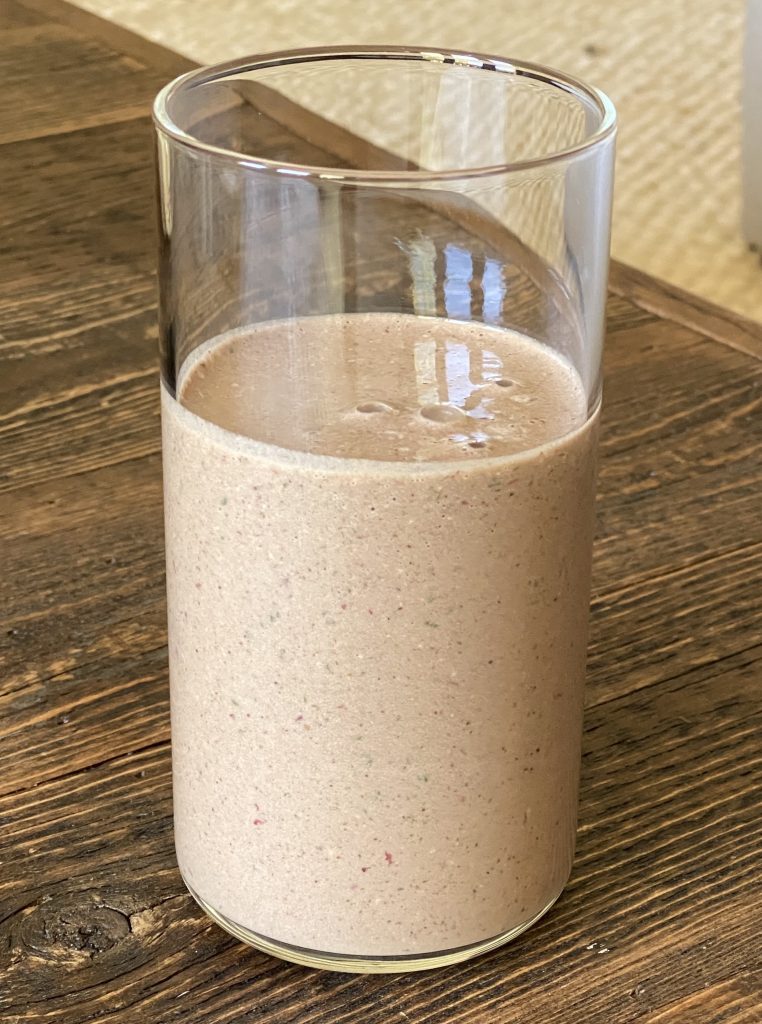
Add-ons (to turn it into a smoothie bowl):
- 1 tablespoon chia seeds
- 1 tablespoon pumpkin seeds
- 1 tablespoon cacao nibs
- 3-5 chopped macadamia nuts
- A few berries

Glucose Response (tested by my co-writer Taylor)
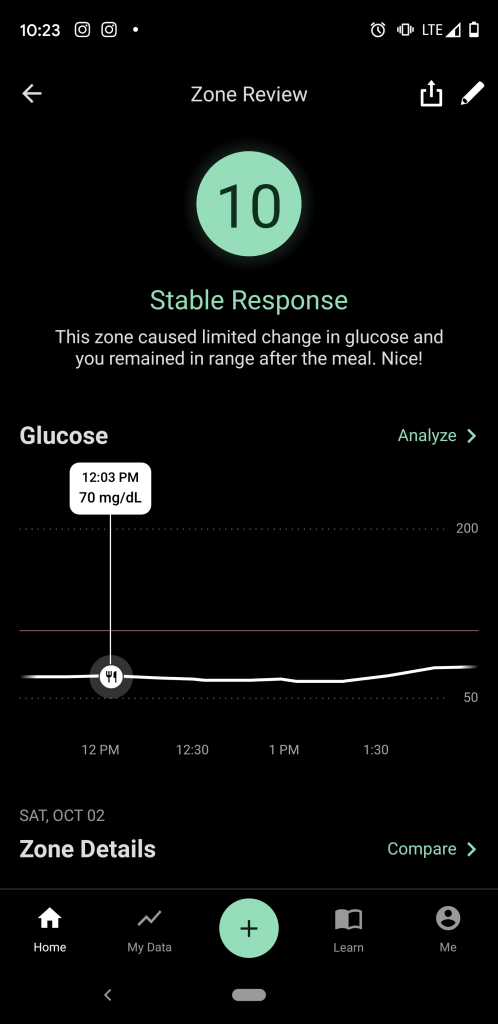
2. Carrot Cake Pumpkin Spice Smoothie Without The Spike
- 2 peeled and chopped medium-sized raw carrots
- ½ cup organic pumpkin puree
- ½ cup organic coconut milk (or whatever milk you like)
- 1 teaspoon cinnamon
- ½ teaspoon nutmeg
- 1 scoop of protein powder
- ¼ cup ice
- 1 tablespoon nut butter
- 1 teaspoon vanilla extract
Blend all of the ingredients.

Add-ons (to turn it into a smoothie bowl):
- 4 or 5 chopped pecans
- Sprinkle of cinnamon
- 1 tablespoon pumpkin seeds
- A few blueberries
- 1 tablespoon raw cacao nibs
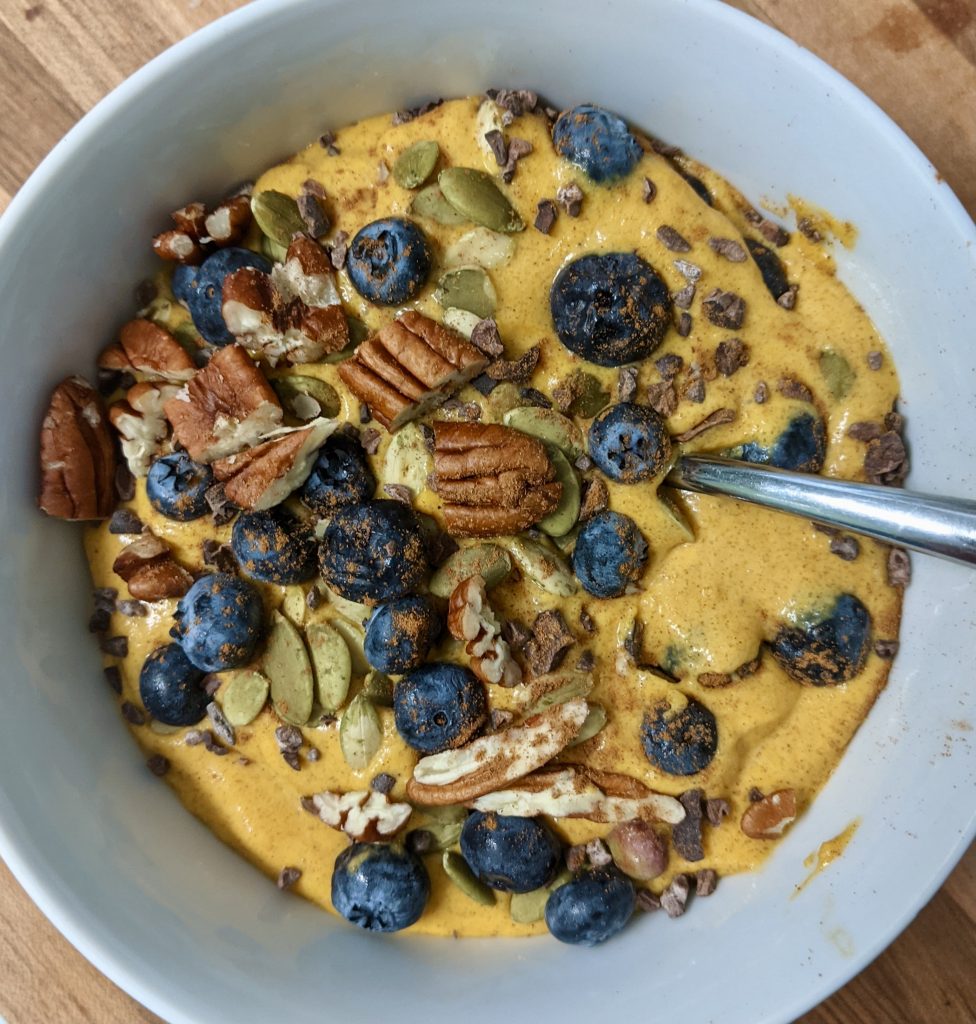
Glucose Response (tested by my co-writer Taylor)
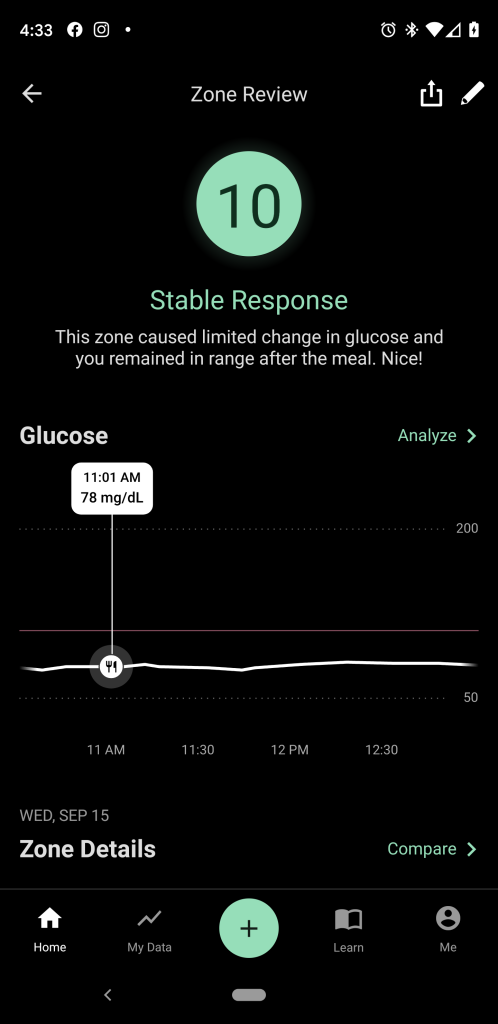
3. Açaí Bowl
- 1 cup almond milk
- 1 unsweetened açaí frozen pack
- ½ avocado
- 1 handful of blueberries
- 1 tablespoon nut butter
- 1 handful of leafy greens
- 1 scoop unflavored protein powder
- 1 teaspoon vanilla extract
Blend all of the ingredients.
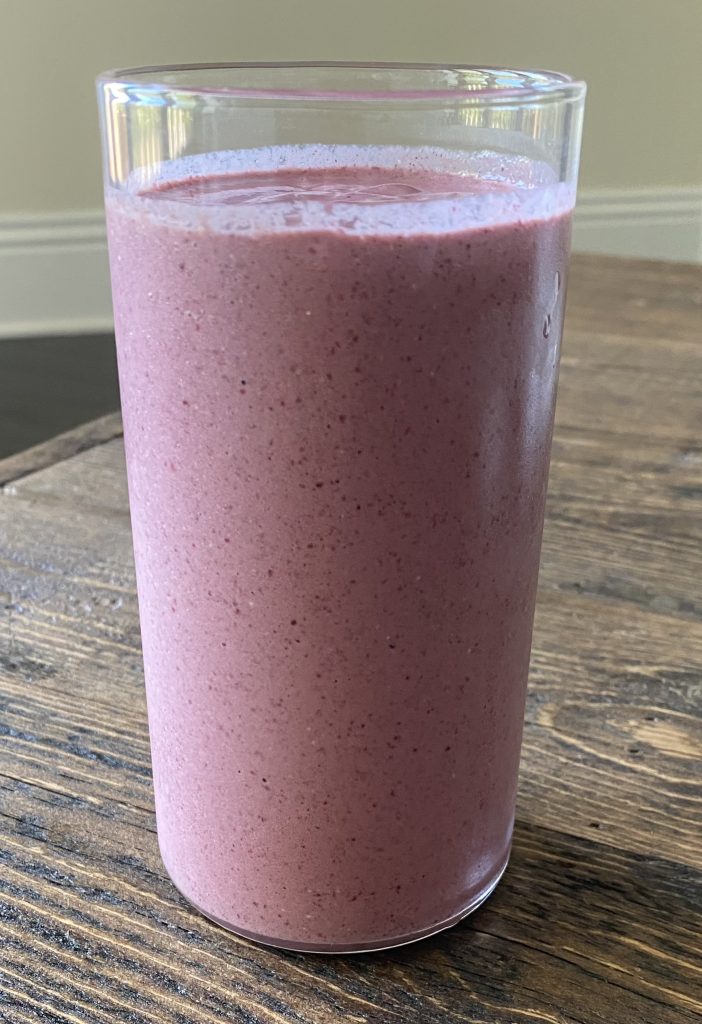
Add-ons (to turn it into a smoothie bowl):
- 1 tablespoon pumpkin seeds (or chia seeds)
- ¼ cup blueberries
- 1 tablespoon raw cacao nibs
- 1 tablespoon nut butter

Glucose Response (tested by my co-writer Taylor)
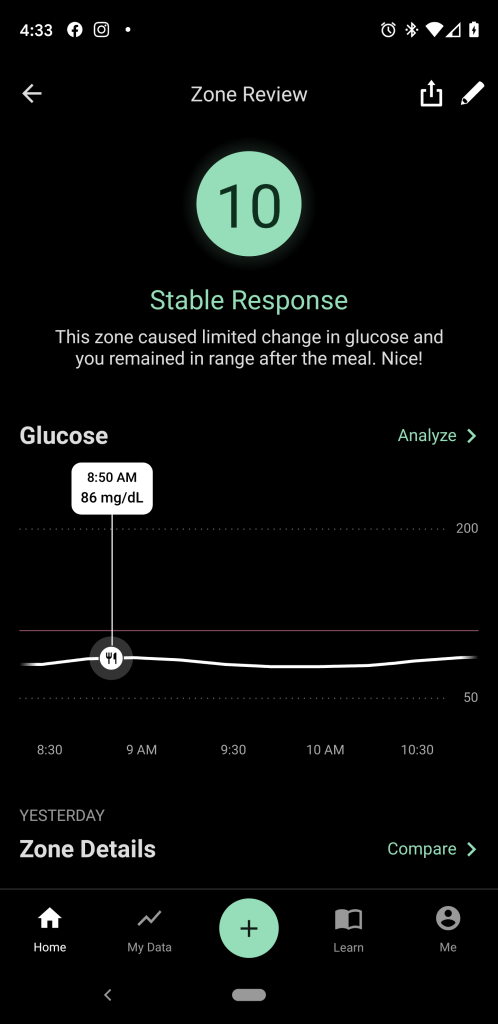
SPLURGE!
- Levels. It wouldn’t be a newsletter about blood sugar if I didn’t plug my favorite CGM brand, Levels. Full transparency, I’m an investor in Levels because I truly believe in their mission of spreading awareness on how our diet and lifestyle impact our blood sugar, metabolic health, and physical well-being. Monitoring your blood sugar is a great way to help protect yourself against chronic disease rooted in blood sugar imbalances.If you want to test these smoothie recipes out on your blood sugar, use my link levels.link/dhru to skip the waitlist and sign up for their early-access program.
Who says you can’t have your smoothie and eat it too?
Hopefully, my three simple smoothie recipes will make you feel better about the ingredients you’re putting into your blender (and your body) to ensure you’re getting maximum nutrient benefits without the blood sugar spike.
These make a great breakfast or snack and have a ton of nutrition, fiber, healthy fats, and protein to keep your blood sugar stable for hours! That way, you can tackle whatever you have going on without dealing with low energy, irritability, or hunger that comes from riding the blood sugar roller coaster.
Here’s to your health,
Dhru Purohit